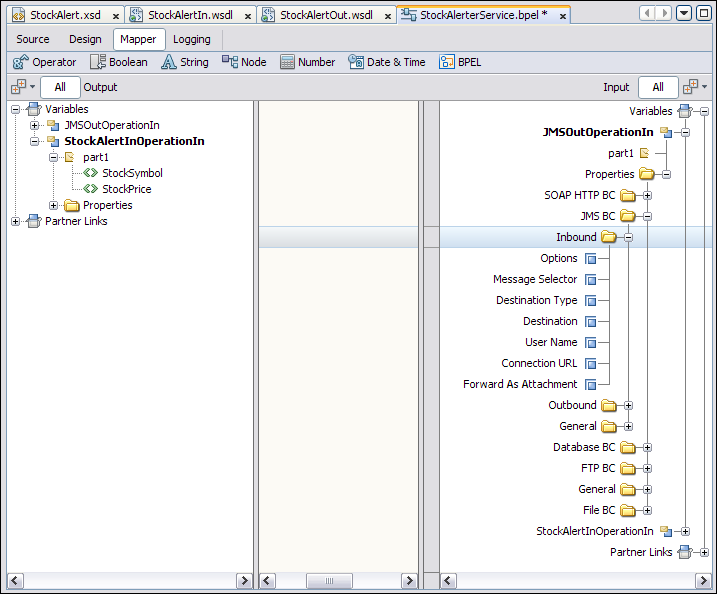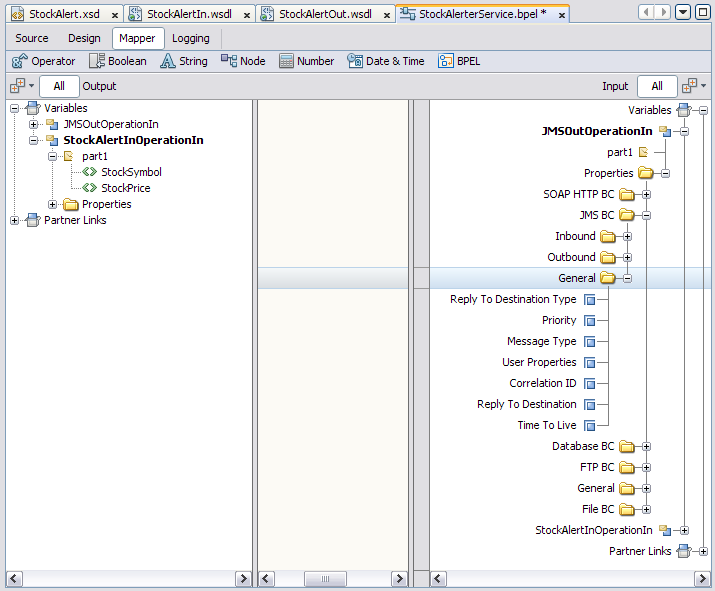| Skip Navigation Links | |
| Exit Print View | |

|
Oracle Java CAPS JMS Binding Component User's Guide Java CAPS Documentation |
| Skip Navigation Links | |
| Exit Print View | |

|
Oracle Java CAPS JMS Binding Component User's Guide Java CAPS Documentation |
Using the JMS Binding Component
JMS Binding Component Overview
JMS Binding Component Features
JMS Binding Component Scenarios
Outbound InOut Exchange Scenario
Inbound InOut Exchange Scenario
Creating JMS-Based Concrete WSDL Documents
To Create a JMS-Based Concrete WSDL Document from the New WSDL Document Wizard
To Create a JMS-Based Concrete WSDL Document from the New File Wizard
Request Connection Configuration
Request Consumer Configuration
Request Publisher Configuration
Response Destination Configuration
Response Consumer Configuration
Response Publisher Configuration
Specifying the Protocol, Server, and Port
Connecting to the JMS Server Using JNDI
Configuring Redelivery Handling
Configuring Redelivery Handling from the Wizard
Configuring Redelivery Handling by Editing the WSDL Document
Using the Normalized Message Properties
Inbound Normalized Message Properties
Connection URL Property (org.glassfish.openesb.jms.inbound.connectionurl)
User Name Property (org.glassfish.openesb.jms.inbound.username)
Message Selector Property (org.glassfish.openesb.jms.inbound.messageselector)
Destination Property (org.glassfish.openesb.jms.inbound.destination)
Destination Type Property (org.glassfish.openesb.jms.inbound.destinationtype)
Forward As Attachment Property (org.glassfish.openesb.jms.inbound.forwardasattachment)
Outbound Normalized Message Properties
Connection URL Property (org.glassfish.openesb.jms.outbound.connectionurl)
User Name Property (org.glassfish.openesb.jms.outbound.username)
Password Property (org.glassfish.openesb.jms.outbound.password)
Destination Property (org.glassfish.openesb.jms.outbound.destination)
Destination Type Property (org.glassfish.openesb.jms.outbound.destinationtype)
XA Transaction Property (org.glassfish.openesb.jms.outbound.xatransaction)
Delivery Mode Property (org.glassfish.openesb.jms.outbound.deliverymode)
Timeout Property (org.glassfish.openesb.jms.outbound.timeOut)
Client ID (org.glassfish.openesb.jms.outbound.clientid)
Message Selector Property (org.glassfish.openesb.jms.outbound.messageselector)
Subscription Durability Property (org.glassfish.openesb.jms.outbound.subscriptiondurability)
Subscription Name Property (org.glassfish.openesb.jms.outbound.subscriptionname)
Forward As Attachment Property (org.glassfish.openesb.jms.outbound.forwardasattachment)
General Normalized Message Properties
Time To Live Property (org.glassfish.openesb.jms.timetolive)
Priority Property (org.glassfish.openesb.jms.priority)
Message ID Property (org.glassfish.openesb.jms.messagetype)
Message Type Property (org.glassfish.openesb.jms.messagetype)
Correlation ID Property (org.glassfish.openesb.jms.correlationid)
Reply To Destination Property (org.glassfish.openesb.jms.replytodestination)
Reply To Destination Type Property (org.glassfish.openesb.jms.replytodestinationtype)
User Properties Property (org.glassfish.openesb.jms.userproperties)
JMS WSDL Extensibility Elements
JMS properties and property Elements
JMS mapmessage and mappart Elements
This topic describes the normalized message properties for the JMS Binding Component. The normalized message properties enable you to do the following:
Override the JMS settings in the WSDL document
Specify JMS user properties
The normalized message properties are divided into the following categories:
This category of normalized message properties applies to inbound-only scenarios.
You can access these properties from the left and right panes of the BPEL Mapper. In the following screen capture, the nodes in the right pane are expanded to show the properties.

These properties are read only. You cannot modify the values.
This property enables you to specify the URL for connecting to the JMS server. It is applicable to the following binding types:
Receive
Receive with Reply
Send and Wait for Reply
On Demand Receive
For more information, see Connecting to the JMS Server.
This property enables you to specify the user name for connecting to the JMS server. It is applicable to the following binding types:
Receive
Receive with Reply
Send and Wait for Reply
On Demand Receive
This property enables you to filter messages. A message selector consists of a boolean expression, such as Age > 30. It is applicable to the following binding types:
Receive
Receive with Reply
On Demand Receive
This property enables you to specify the name of the JMS destination from which messages are received. It is applicable to the following binding types:
Receive
Receive with Reply
Send and Wait for Reply
On Demand Receive
This property enables you to indicate whether the JMS destination is a queue or a topic. The valid values are Queue and Topic It is applicable to the following binding types:
Receive
Receive with Reply
Send and Wait for Reply
On Demand Receive
This property enables you to send the message data as an attachment. The valid values are true and false. For binary data, the data is sent as an attachment by default.
For XML data, sending the data as an attachment prevents the JMS Binding Component from parsing the XML. If the XML is large, then this approach can improve performance.
This property is applicable to the following binding types:
Receive
Receive with Reply
Send and Wait for Reply
On Demand Receive
This category of normalized message properties applies to outbound-only scenarios. You can access these properties from the left and right panes of the BPEL Mapper. In the following screen capture, the nodes in the right pane are expanded to show the properties.

This property enables you to specify the URL for connecting to the JMS server. It is applicable to the following binding types:
Receive with Reply
Send
Send and Wait for Reply
On Demand Receive
For more information, see Connecting to the JMS Server.
This property enables you to specify the user name for connecting to the JMS server. It is applicable to the following binding types:
Receive with Reply
Send
Send and Wait for Reply
On Demand Receive
This property enables you to specify the password for connecting to the JMS server. It is applicable to the following binding types:
Receive with Reply
Send
Send and Wait for Reply
On Demand Receive
This property enables you to specify the name of the JMS destination to which messages are sent. It is applicable to the following binding types:
Send
Send and Wait for Reply
On Demand Receive
This property enables you to indicate whether the JMS destination is a queue or a topic. The valid values are Queue and Topic. it is applicable to the following binding types:
Send
Send and Wait for Reply
On Demand Receive
This property enables you to define the transaction type for the JMS protocol based operation. The valid values are NoTransaction and XATransaction. It is applicable to the following binding types:
Receive with Reply
Send
On Demand Receive
This property enables you to specify the message delivery mode to use when sending a message. The valid values are PERSISTENT and NON_PERSISTENT. It is applicable to the following binding types:
Receive with Reply
Send
Send and Wait for Reply
This property enables you to specify the timeout in milliseconds on a message consumer receive for a reply message. It is applicable to the following binding types:
Send and Wait for Reply
On Demand Receive
This property defines a unique client ID. It is applicable to the On Demand Receive binding type.
This property enables you to filter messages. A message selector consists of a boolean expression, such as Age > 30. It is applicable to the On Demand Receive binding type.
This property enables you to configure the durability of the topic subscriber. Durable subscribers can survive any disconnection from the JMS server.
The valid values are Durable and NonDurable.
This property is applicable to the On Demand Receive binding type.
For durable subscriptions, this property enables you to specify the name of the durable subscription.
This property is applicable to the On Demand Receive binding type.
This property enables you to send the message data as an attachment. The valid values are true and false. For binary data, the data is sent as an attachment by default.
For XML data, sending the data as an attachment prevents the JMS Binding Component from parsing the XML. If the XML is large, then this approach can improve performance.
This property is applicable to the following binding types:
Send and Wait for Reply
On Demand Receive
This category of normalized message properties applies to both inbound and outbound scenarios.
You can access these properties from the left and right panes of the BPEL Mapper. In the following screen capture, the nodes in the right pane are expanded to show the properties.

This property indicates how long the message is retained (in milliseconds). It is applicable to the following binding types:
Receive with Reply
Send
Send and Wait for Reply
This property enables you to specify the message priority for a message producer. The valid values are 0 through 9, where 0 is the lowest priority and 9 is the highest priority. The default value is 4. It is applicable to the following binding types:
Receive with Reply
Send
Send and Wait for Reply
This property enables you to reference the message part that contains the value for the JMSMessageID header. It is applicable to the following binding types:
Receive with Reply
Send
Send and Wait for Reply
This property enables you to specify whether the messages are text, bytes, XML, or encoded data. It is applicable to the following binding types:
Receive with Reply
Send
Send and Wait for Reply
This property enables you to reference the message part that contains the value for the JMSCorrelationID header. You can use a JMS correlation ID to associate a reply message with the corresponding request message.
This property is applicable to the following binding types:
Receive with Reply
Send
Send and Wait for Reply
This property enables you to specify the name of the JMS destination to which messages should be replied. It is applicable to the following binding types:
Receive with Reply
Send
Send and Wait for Reply
This property enables you to indicate whether the JMS destination is a queue or a topic. The valid values are Queue and Topic. It is applicable to the following binding types:
Receive with Reply
Send
Send and Wait for Reply
This property enables you to configure JMS properties, which are custom headers. It `is the only normalized message property that you cannot configure in the BPEL Mapper. Instead, you must go to the Source view and manually enter a copy statement. Add a period and the property name to org.glassfish.openesb.jms.userproperties. For example:
<copy>
<from>$SoapInboundOperationIn.part1/ns0:StockSymbol</from>
<to variable="JMSOutOperationIn"
sxnmp:nmProperty="org.glassfish.openesb.jms.userproperties.StockSymbol"/>
</copy>
The default property type is string. If you want to specify a type other than string, then you must enter an additional copy statement for the type. For example:
<copy>
<from>$SoapInboundOperationIn.part1/ns0:StockPrice</from>
<to variable="JMSOutOperationIn"
sxnmp:nmProperty="org.glassfish.openesb.jms.userproperties.StockPrice"/>
</copy>
<copy>
<from>'float'</from>
<to variable="JMSOutOperationIn"
sxnmp:nmProperty="org.glassfish.openesb.jms.userproperties.StockPrice.type"/>
</copy>
This property is applicable to all of the binding types.